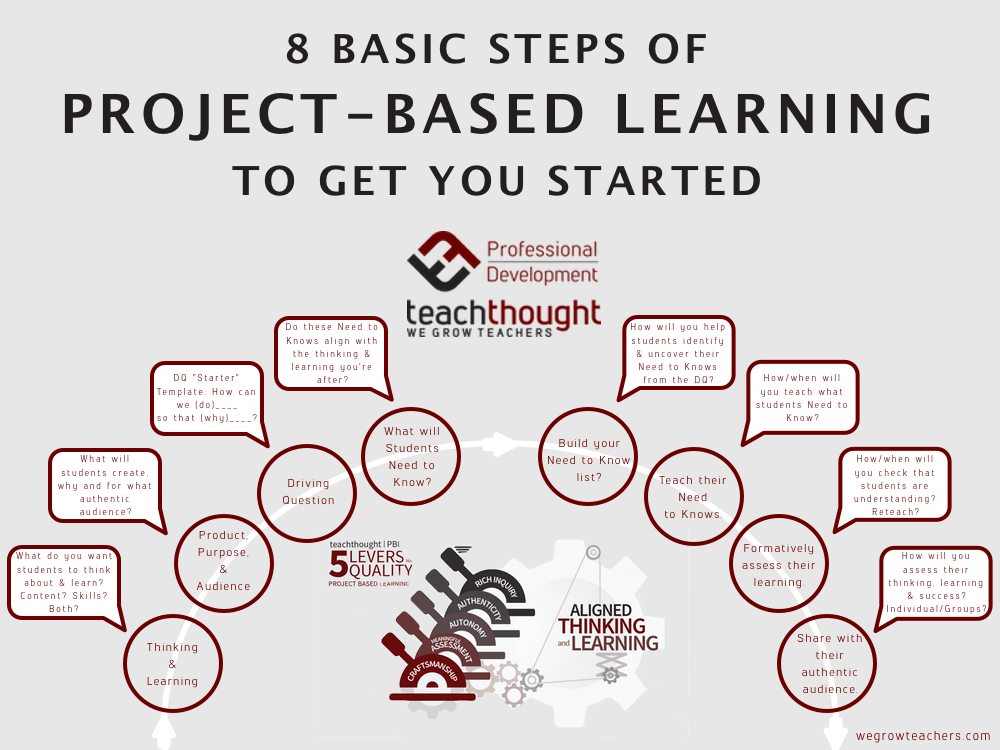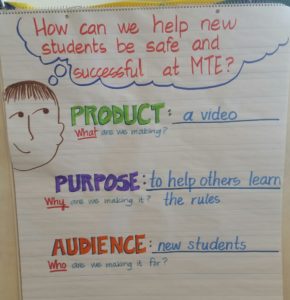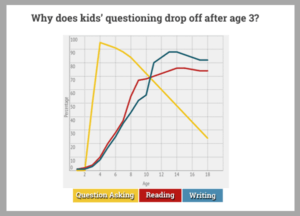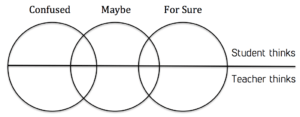
8 Steps For Teaching Through Project-Based Learning
contributed by Drew Perkins
The process of designing and implementing project-based learning can be fairly complex.
A big part of that complexity is the shift toward inquiry that uncovers learning as you use PBL to flip Bloom’s Taxonomy. With that said, it’s often helpful to break this process down into basic steps to help teachers and schools start with the caveat that PBL planning and implementation is not a simple, linear process.
Readers should keep in mind that some of these ‘steps’ can occur simultaneously as the reality of the messiness of learning and planning for deeper learning kicks in.
1. Start with the student.
Many times teachers begin project ideation and planning with content standards as the end in mind.
What is it that we want students to think about and learn? For many classrooms, this is course content and skills like collaboration or communication. In settings like Genius Hour/20% Time, ‘content’ may not drive your project and you might focus more on skills. Either way, you want to be thoughtful about the journey you’re hoping for those student brains to take and the eventual destination. You’ll also want to consider your plan for individual vs. group accountability.

I like to remind workshop participants that we’re not graduating groups or teams but individuals, so I suggest a heavier emphasis (80/20?) on individual accountability. It’s worth noting that starting project ideation this way isn’t the only way to get going. Teachers often begin with a great connection to an authentic purpose or audience or by leveraging an interesting student product/creation idea. Even so, you’ll want to come back around to what it is you’d like students to think about and learn.
As you’re doing this, it’s essential to design projects that engage students in questions that are important to them, not just important to us as teachers.
2. Clarify audience and purpose.
In quality PD where teachers design projects, we stress clarity around product, purpose, and audience. It’s not only important for teachers to be clear in their design process, it’s vital for students. What will they make or create? Why are they making it and for whom?
As you’ll see in the next step, this can be explicit in the Driving Question or in other project documents and messaging. In our PBL observation and feedback sessions with teachers and schools we often ask students what they’re doing and why. Ideally, we want them to articulate that connection between their work and the authentic purpose and audience.
It’s that kind of grounding that allows teachers to leverage thinking and learning toward craftsmanship by returning to the question of how well the work is meeting the needs of the audience and the purpose of the project.
3. Create a driving question.
A Driving Question is just that, an open-ended question that drives thinking and learning. This is what we want students to be working to answer in the process of their project and if they can answer the DQ without thinking and learning about what you planned for you’ve got a misalignment.
There is no such thing as the perfect Driving Question as mileage varies with different teachers, students, and projects but I do think it can be helpful to start with clarity around product, purpose, and audience. To help teachers in our workshops we provide the DQ “Starter” Template pictured. We say ‘starter’ because you likely will want to refine it to be more interesting to students but it helps with clarity before getting too deep into project planning.
4. Determine what students will need to know.
As noted before, project-based learning is not a simple, linear process. You should have already considered what students need to know for your project DQ but as you refine and revise it’s always important to re-check your alignment.
Walk through the process as a learner asking yourself what content and/or skills would be necessary for you to complete the challenge? Can students finish the project and answer the Driving Question without the thinking and learning you likely need for them to experience? If not, double back and revise your DQ and project’s focus because we don’t want to get to the project end and just hope they learned some good stuff.
That’s not to say that they won’t or shouldn’t learn many things you hadn’t expected but that accidental learning should be in addition to what you’ve planned for, taught and assessed.
5. Determine teacher actions.

The pedagogical relationship between the Driving Question and Need to Know list is essential to the heart of PBL. This is the process by which we’re empowering students as learners through rich inquiry. As the challenge is posed and revisited students should have questions but they may not yet have developed this skill. In many cases their questions have been ‘educated’ out of them as school has asked them to focus more on answers.
Whatever the case, you’ll want to consider what scenarios you’ll create to help them discover and uncover these Need to Know questions. What new learning will you present them with? What questions will you ask that will help them think through what they’ll need to complete their project?
Sometimes you’ll need to be a bit more leading with your facilitation of this process but it’s vital to get those pieces identified as you move along. Doing so helps contextualize your teaching and shifts the paradigm from ‘I’m the teacher, here’s what you need to know and learn’ to ‘I’m the student, help me learn what I need to know.’
6. Help them learn what they need to know.
You’ve launched your project with an Entry Event to hook students, provided them with their Driving Question and started soliciting their Need to Knows. Now it’s time to teach. One fear with PBL is that teachers don’t teach but that’s not true. Many of the things you’ve done to teach content and/or skills in the past are now contextualized scaffolding. This is where you’ll want to use planning documents and whatever planning calendar you’re comfortable with.
Flexibility is, of course, important but heading into a project without planning for when and how you’ll teach the things your students will need is a recipe for disaster. What will you do to help students think and learn about the content and skills you’re after? What questions will help guide their work each day? How will you help them make the connection between what you’re doing as a teacher and the Need to Knows they’ve identified?
Part of the science of teaching is in lesson planning and design but I think it’s also what helps us showcase the art of teaching where you’re responsive and able to meet students at the point of productive struggle without them shutting down.
7. Assess.
You’ve planned and taught and worked really hard but how will you know if your students ‘got it’? Often we’re really great at ‘teacher does’ but sometimes forget the ‘student does.’ If it’s worth teaching it’s certainly worth formatively assessing and it’s absolutely necessary if you want to avoid getting to the end and having a train wreck. Beginning PBL teachers frequently say in reflection that they wished they’d built in more checkpoints/formative assessments.

They don’t necessarily have to be formal and can often take the form of observations, dialogue, and peer critique but you shouldn’t build a house and wait until you’re done to test the structural integrity. One of my favorite ways to formatively assess learning was to ask students to answer a few questions and complete the top part of the “confidence meter” to the left with a check mark. This allowed me to collect more information about their thinking and since it wasn’t worth points, it focused the process on their learning.
What will you do with students who didn’t understand? Can you use peer groups to help build capacity in those who are ‘maybes’ or ‘confused’? Can you schedule workshops with those students while others move forward? There are many ways to respond to formative assessment but you have to know if students are progressing while in the project, not just at the end.
8. Publish with the intended audience.
Toward the end of the PBL process you’ll want students to share their work, thinking, and learning with their authentic audience but be sure this audience is clear to students prior to project kickoff. When teachers make the mistake of not clarifying who the student work is for before they start they lose the leverage point of refining work to meet those needs of that person, group, or entity.
As students make their work public how will you (and others?) assess? Keep in mind that despite education’s focus for many years on summative assessments not all content and/or skills need to be evaluated at this specific point. Much of the project content is often best assessed in the process and outside of presentations but each project is different. As I noted before, you’ll want to consider how you’ll weigh and assess groups/teams vs. individuals and the content and skills.
Also, don’t neglect the post-project reflection opportunity for you and your students. This is a great time for everyone to consider things like what they learned, what they could have done better, what they liked and struggled with and what they thought were real strengths. This metacognitive process can help deepen learning but also help teachers and students improve upon their practice.
If great teaching and learning were as easy as 8 steps education would be in a much better place but it’s not. Recognizing the complexity of creating quality learning scenarios take real work and hopefully these basics give you a jumping off point.
Want to hear me explain this graphic? Click to watch the video below.
